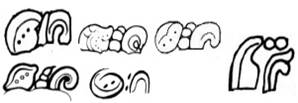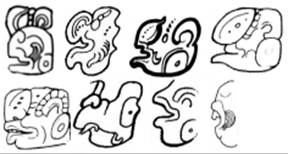
![]()
![]()
K&L.p24.#7.9-14 TOK.p10.r2.c4 BMM9.p11.r1.c1
TI’ TI’ TI’
![]()


 .
.
T128b = T168f Gronemeyer-GGF.p12.pdfp12.fig11.l = TMHW.pdfp432.F.59 TMHW.pdfp432.F.
- YAX Lintel 48 D7 QRG Stela K B5
TI’:HUUN:na HUUN.<<“po”?.TI’>:na>

![]()

![]()
K&L.p24.#7.1-8 TOK.p21.r2.c1 BMM9.p15.r1.c1 BMM9.p17.r1.c1
TI’ TI’ TI’ TI’
![]()
![]()
TOK.p32.r5.c3 BMM9.p21.r2.c3
TI’ TI’
· No glyphs given in K&H.
· Variants (3):
o A. Abstract / rectangular / 3-component – features:
§ Left: cave-like element with 3 to 5 very small dots going from bottom left to top right, in a slight arc which follows the line of the bold wall/ceiling.
§ Middle: 2 – 3 dots stacked vertically, tending slightly towards to right as they go up, last dot can be a leaf (similar to the middle element of the 3-component ya).
§ Right: bloated crescent with tips pointing down (or right bold feeler) – optionally with reinforcement of spine.
There are some (quite rare?) sub-variants of this variant – the leftmost component resembles the wing of a bird, i.e., looks like the “single wing” variant of k’i, or the “simple wing” variant of K’A’:
§ A 2-component sub-variant where the middle component of the 3-component form is missing.
· See T128b in the examples above.
· Thompson assigned this glyph the codes T128b and (unusually for Thompson) T168“f” (He didn’t explicitly assign the -f suffix, but it can be conveniently placed after T168abcde).
· In so doing, Thompson was correct in classifying T128b together with T128a and T128cd as variants of T128 (all TI’), but he was incorrect in classifying it also as T168“f”, as all the other variants T168abcde are AJAW.
· He might have done this on the basis of QRG Stela K B5 (see example above) where there’s a puzzling po-like (i.e., “cushion”/”ICH”) element between the vertical HUUN on the left and the TI’:na on the right (the na being, despite its position) just an end phonetic complement for the HUUN).
§ A 3-component sub-variant where the only difference between it and the regular 3-component form is that the leftmost component resembles the simple/single wing variants of k’i/K’A’.
· See YAX Lintel 48 D7 in the examples above.
o B. Representational / human head:
§ Largish nose.
§ Open mouth with thick lips (optionally reinforced or bolded).
§ Partitive disk in bottom right corner.
§ The 3-component variant can optionally also appear above or infixed into the human head, in particular the far-left element of the three.
Note that BMM9.p15.r1.c1 is quite an aberrant variant – it doesn’t have the open mouth with thick lips of the others, but instead has two scrolls (which the others don’t have). Furthermore, it has a very large, squarish, cross-hatched eye and what might be a cruller under and to the right of the eye. TOK.p21.r2.c1 is also aberrant (but less than BMM9.p17.r1.c1) – it doesn’t have any elements of the reduced variant at the top of the head. This is however also known from K&L.p24.#7.6-8, and from BMM9.p17.r1.c1.
o C. Stylized-face:
§ Above: two feelers with protectors.
§ Below: stylize face:
· Top half: three non-touching dots in a triangular formation, with the triangle pointing up (“upside-down face”), the top dot touching the ceiling.
· Bottom half: resembles the bottom half of HAAB.
Variants A and B (but not C) are commonly found as the first word in the phrase ti’ huun = Glyph-F of the Supplementary series. In contrast, Variant C (but not A or B) forms, in combination with an old variant of HUL, one of the variants of Glyph-G2 of the Supplementary series.